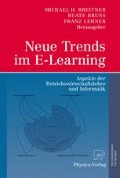Auszug
Unabhängig von der verwendeten Beschreibungssprache weisen Lernobjekte eine hierarchische Gliederung mit partieller Vernetzung auf und können als Spezialform elektronischer Dokumente in einem festgelegten Vokabular angesehen werden. Der Beitrag erweitert eine bestehende Algebra für strukturierte Dokumente um den Aspekt der Mehrdimensionalität bzw. des Kontexts. Es wird formalisiert und am Beispiel von Lernobjekten demonstriert, wie der Kontext eines Dokuments spezifiziert und verarbeitet wird sowie welche Rahmenbedingungen dabei gelten. Eine auf der Grundlage dieses algebraischen Referenzmodells implementierte Unterstützung durch Autorenwerkzeuge wird vorgestellt und so die praktische Relevanz des Ansatzes untermauert.
Access this chapter
Tax calculation will be finalised at checkout
Purchases are for personal use only
Preview
Unable to display preview. Download preview PDF.
Literaturverzeichnis
ADL. Sharable Content Object Reference Model (SCORM). http://www.adlnet.org/technologies/SCORM/
Adobe Inc. Adobe FrameMaker. http://www.adobe.com/products/framemaker/
Beeri C, Tzaban Y (1999) SAL: An Algebra for Semistructured Data and XML. ACM SIGMOD Workshop on The Web and Databases (WebDB), 1999
Bunschkowski M, Röser M, Tavangarian D, Voigt D (2004) Eine differenzierte Metadatennotation XML-basierter E-Learning-Ressourcen für ein zuverlässiges Metadatenmanagement. 2. Deutsche eLearning Fachtagung Informatik (DeLFI), 2004
Bush V (1945) As we may think. The Atlantic Monthly 176/1, Juli 1945
Codd EF (1970) A Relational Model of Data for Large Shared Data Banks. ACM Communications, Band 13, Nr 6, Juni 1970
Damm M, Klauer B, Waldschmidt K (2003) LogiFlash — A Flash-based Logic-Simulator for educational Purposes. World Conference on Educational Multimedia, Hypermedia & Telecommunications (Ed-Media), 2003
Fernández M, Siméon J, Wadler P (2000) An Algebra for XML Query. International Conference on Foundation of Software Technology and Theoretical Computer Science (FSTTCS 2000), LNCS 1974. Springer Verlag
Fronk A (2002) Algebraische Semantik einer objektorientierten Sprache zur Spezifikation von Hyperdokumenten. Dissertation, Universität Dortmund
Güting RH, Zicari R, Choy DM (1989) An Algebra for Structured Office Documents. ACM Communications on Office Information Systems, Band 7, Nr 2, April 1989
Halasz F, Schwartz M (1994) The Dexter Hypertext Reference Model. ACM Communications, Band 37, Nr 2, Februar 1994
ILIAS. ILIAS Open-Source. http://www.ilias.de/
IMC Advanced Learning Solutions. CLIX Learning Management System. http://www.im-c.de/
Joachim S, Bothe K (2005) Interaktive Werkzeugbasierte Entwicklung von mehrsprachigem Lehr-und Lernmaterial. 3. Deutsche eLearning Fachtagung Informatik (DeLFI), 2005
Kornelsen L, Lucke U, Tavangarian D, Waldhauer M, Ossipova N (2004) Strategien und Werkzeuge zur Erstellung multimedialer Lehr-und Lernmaterialien auf Basis von XML. 2. Deutsche eLearning Fachtagung Informatik (DeLFI), 2004
Lausen G, Vossen G (1996) Objekt-orientierte Datenbanken: Modelle und Sprachen. Oldenbourg Verlag, München
Lucke U (2005) Eine formale Algebra für die strukturierte Dokumetenverarbeitung. 3. Deutsche e-Learning Fachtagung Informatik (DeLFI), 2005
Lucke U, Nölting K, Tavangarian D (2005) Strukturierte Lehr-und Lernmodelle für die Ausbildung im Fachgebiet Technische Informatik. Information Technology (it), Band 47, Nr 3, 2005
Lucke U, Tavangarian D (2002) Turning a Current Trend into a Valuable Instrument: Multidimensional Educational Multimedia based on XML. World Conference on Educational Multimedia, Hypermedia and Telecommunications (Ed-Media), 2002
Mani M, Lee D, Muntz RR (2001) Semantic Data Modeling using XML Schemas. 20th International Conference on Conceptual Modeling, 2001
Multidimensional LearningObjects and Modular Lectures Markup Language. http://www.ml-3.org/
Multimedia in Sicheren Systemen. http://www.informatik.uni-bremen.de/mmiss/
Nilsson M, Johnston P, Naeve A, Powell A. The Future of Learning Object Metadata Interoperability: Towards an Interoperability Framework for Metadata Standards. http://kmr.nada.kth.se/~mini/FutureOfLOMI.doc
OOo. Open Office Writer. http://www.openoffice.org/product2/writer.html
Schmid M, Stynes J, Kröger R (2004) A Distributed Architecture for Learning Management Systems Supporting Institutional Collaboration. World Conference on Educational Multimedia, Hypermedia & Telecommunications (Ed-Media), AACE, Charlottesville/Virginia/USA, 2004
Sengupta A, Mohan S (2003) Formal and conceptual models for XML structures — the past, present, and future. Indiana University/USA, Technical Report TR 137-1, April 2003
Sommaruga L, Catenazzi N (2004) An Approach to Content Re-usability and Adaptability in E-Learning. World Conference on Educational Multimedia, Hypermedia and Telecommunications (Ed-Media), 2004
Stavrakas Y, Gergatsoulis M, Rondogiannis P (2000) Multidimensional XML. 3rd International Workshop on Distributed Computing on the Web (DCW), 2000
Stud.IP. http://www.studip.de/
Subieta K, Kambayashi Y, Leszczylowski J, Yokota K (1995) Object Algebras: What is Wrong? (unpublished) 1995. http://citeseer.ist.psu.edu/42952.html
Vossen G (2000) Datenmodelle, Datenbanksprachen und Datenbankmanagementsysteme. Oldenbourg Verlag, München
Wissenswerkstatt Rechensysteme. http://www.wwr-project.de/
World Wide Web Consortium (W3C). http://www.w3.org/
Author information
Authors and Affiliations
Editor information
Editors and Affiliations
Rights and permissions
Copyright information
© 2007 Physica-Verlag Heidelberg
About this chapter
Cite this chapter
Lucke, U. (2007). Ein Referenzmodell für mehrdimensionale Lernobjekte. In: Breitner, M.H., Bruns, B., Lehner, F. (eds) Neue Trends im E-Learning. Physica-Verlag HD. https://doi.org/10.1007/978-3-7908-1922-9_20
Download citation
DOI: https://doi.org/10.1007/978-3-7908-1922-9_20
Publisher Name: Physica-Verlag HD
Print ISBN: 978-3-7908-1917-5
Online ISBN: 978-3-7908-1922-9
eBook Packages: Business and Economics (German Language)

